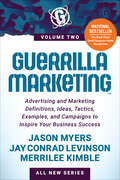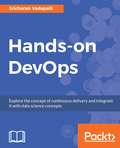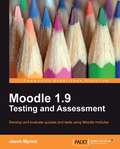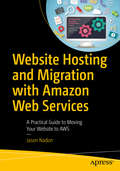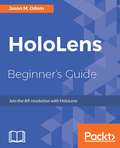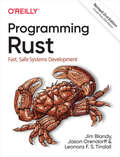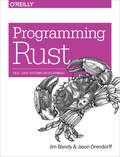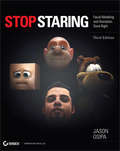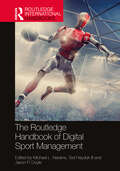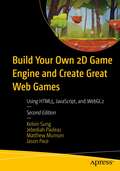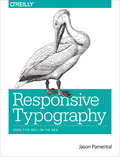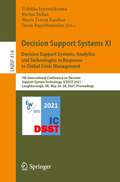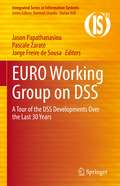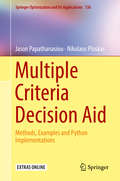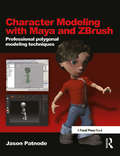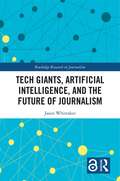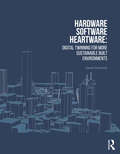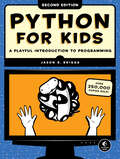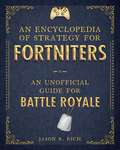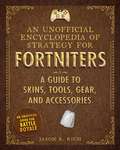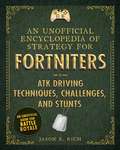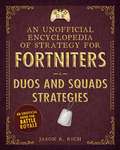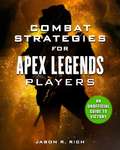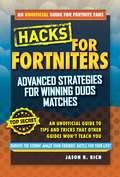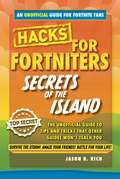- Table View
- List View
Guerrilla Marketing: Advertising and Marketing Definitions, Ideas, Tactics, Examples, and Campaigns to Inspire Your Business Success
by Jay Conrad Levinson Jason Myers Merrilee KimbleFocused on low-cost, strategic marketing concepts that will creatively promote a compelling product or service, Guerrilla Marketing’s winning approach relies on knowledge, time, energy, and imagination rather than a big marketing budget. Now, the winning continues with Guerrilla Marketing Volume 2.
Hands-on DevOps: Explore the concept of continuous delivery and integrate it with data science concepts
by Sricharan Vadapalli Prakash Sarma Jason MyerscoughKey FeaturesLearn the concepts of Bigdata and Devops and Implement themGet Acquainted with DevOps Frameworks Methodologies and Tools A practical approach to build and work efficiently with your big data clusterGet introduced to multiple flavors of tools and platforms from vendors on Hadoop, Cloud, Containers and IoT OfferingsIn-Depth Technology understanding on Data Sciences, Microservices, BigdataBook DescriptionDevOps strategies have really become an important factor for big data environments.This book initially provides an introduction to big data, DevOps, and Cloud computing along with the need for DevOps strategies in big data environments. We move on to explore the adoption of DevOps frameworks and business scenarios. We then build a big data cluster, deploy it on the cloud, and explore DevOps activities such as CI/CD and containerization. Next, we cover big data concepts such as ETL for data sources, Hadoop clusters, and their applications. Towards the end of the book, we explore ERP applications useful for migrating to DevOps frameworks and examine a few case studies for migrating big data and prediction models.By the end of this book, you will have mastered implementing DevOps tools and strategies for your big data clusters.What you will learnLearn about the DevOps culture, its frameworks, maturity, and design patternsGet acquainted with multiple niche technologies microservices, containers, kubernetes, IoT, and cloud Build big data clusters, enterprise applications and data science modelsApply DevOps concepts for continuous integration, delivery, deployment and monitoringGet introduced to Open source tools, service offerings from multiple vendorsStart digital journey to apply DevOps concepts to migrate big data, cloud, microservices, IoT, security, ERP systems
Moodle 1.9 Testing and Assessment
by Jason MyrickThis book is an illustrative how-to guide with many screenshots and examples that helps you to create simple to complex tests and assess them using Moodle. It covers effective usage of tools available in Moodle and offers some Moodle options that you may not have tried yet. It will guide you from the basic philosophy of online testing to creating skill-based assessments in Moodle.If you are a tutor or Moodle Administrator who is responsible for developing and evaluating an online test using Moodle, then this book is for you.This book assumes that you have already successfully installed and set up a Moodle site for teaching.
Website Hosting and Migration with Amazon Web Services
by Jason NadonUnderstand the steps necessary to host your website using the Amazon Web Services (AWS) platform. You will be able to set up your website for the first time or migrate your existing website. Explore scenarios, considerations, and steps for three types of websites, including hosting a static website, a content management system (CMS) based website, and a full-featured enterprise level website. Topic areas such as content storage in S3, compute resources in EC2, Route53 DNS Management, email services setup using Simple Email Service as well as strategies for high availability, fault tolerance, and website maintenance are covered. Website Hosting and Migration with Amazon Web Services is organized in a way that allows you to start with simple concepts using AWS core services that allow you to build knowledge and confidence using AWS services while exploring the latest technology on this ever-updating platform. Using AWS to host your website offers you more control over your infrastructure, content delivery, and ability to scale to fit your website needs. It's time to take control and take your website to the next level. This engaging resource: Explains how to use the Amazon Web Services Free Tier to evaluate the platform for hosting your website Walks you through the setup and migration steps for three unique and popular web hosting scenarios Delivers hands-on experience with base concepts that can be built upon to grow and improve your website infrastructure Provides sample resources to test and understand the setup process fully What You'll Learn Evaluate Amazon Web Services (AWS) offered on the platform that may benefit your website Set up and maintain three unique types of websites using AWS core services, enabling you to gain a deeper understanding of what is capable for your website or future projects Select AWS services that can improve performance and control of your website Manage DNS, domain registration, and transfers in AWS Use CloudFront to deliver content efficiently on a global scale Use AWS RDS to deliver a redundant database solution for your website Who This Book Is For Small business owners, webmasters, freelance web designers, and others looking to have more control over their web content, save money by using a platform that charges for just the services you use, or grow the stability of their website by making it highly available, fault tolerant, and easily deployed; those looking to learn more about AWS Web Hosting options in general
HoloLens Beginner's Guide
by Jason OdomCreate interactive and intuitiveness HoloLens applications with ease About This Book • Start developing immersive and interactive apps for Microsoft HoloLens • Explore the Windows Universal Development platform for HoloLens development • Leverage the full set of HoloLens sensors to create mesmerizing apps Who This Book Is For If you are a developer new to Windows Universal development platform and want to get started with HoloLens development, then this is the book for you. No prior experience of C# programming or of the .NET framework is needed to get started with this book. What You Will Learn • Write an app that responds to verbal commands • Communicate between devices in the boundaries of the UWP model • Create sounds in the app and place them in a 3D space • Build simple apps that display holograms • Interact with the physical environment while taking physical boundaries into account In Detail HoloLens revolutionizes the way we work and interact with the virtual world. HoloLens brings you the amazing world of augmented reality and provides an opportunity to explore it like never before. This is the best book for developers who want to start creating interactive and intuitive augmented reality apps for the HoloLens platform. You will start with a walkthrough of the HoloLens hardware before creating your first app. Next you will be introduced to the various HoloLens sensors and find out how to program them efficiently so that they can interact with the real world seamlessly. Moving on, you will learn how to create smart animations and add video overlay that implements real-time tracking and motion-sensing abilities to your HoloLens app. Finally, you will learn how to test your app effectively. Style and approach This book takes a step-by-step tutorial-style approach. It will guide you through every step with practical examples and make sure that you are confident enough to create your own HoloLens app from scratch by the end of the book.
Programming Rust
by Jim Blandy Jason Orendorff Leonora F. S. TindallSystems programming provides the foundation for the world's computation. Writing performance-sensitive code requires a programming language that puts programmers in control of how memory, processor time, and other system resources are used. The Rust systems programming language combines that control with a modern type system that catches broad classes of common mistakes, from memory management errors to data races between threads.With this practical guide, experienced systems programmers will learn how to successfully bridge the gap between performance and safety using Rust. Jim Blandy, Jason Orendorff, and Leonora Tindall demonstrate how Rust's features put programmers in control over memory consumption and processor use by combining predictable performance with memory safety and trustworthy concurrency.You'll learn:Rust's fundamental data types and the core concepts of ownership and borrowingHow to write flexible, efficient code with traits and genericsHow to write fast, multithreaded code without data racesRust's key power tools: closures, iterators, and asynchronous programmingCollections, strings and text, input and output, macros, unsafe code, and foreign function interfacesThis revised, updated edition covers the Rust 2021 Edition.
Programming Rust: Fast, Safe Systems Development
by Jim Blandy Jason OrendorffRust is a new systems programming language that combines the performance and low-level control of C and C++ with memory safety and thread safety. Rust’s modern, flexible types ensure your program is free of null pointer dereferences, double frees, dangling pointers, and similar bugs, all at compile time, without runtime overhead. In multi-threaded code, Rust catches data races at compile time, making concurrency much easier to use.Written by two experienced systems programmers, this book explains how Rust manages to bridge the gap between performance and safety, and how you can take advantage of it. Topics include:How Rust represents values in memory (with diagrams)Complete explanations of ownership, moves, borrows, and lifetimesCargo, rustdoc, unit tests, and how to publish your code on crates.io, Rust’s public package repositoryHigh-level features like generic code, closures, collections, and iterators that make Rust productive and flexibleConcurrency in Rust: threads, mutexes, channels, and atomics, all much safer to use than in C or C++Unsafe code, and how to preserve the integrity of ordinary code that uses itExtended examples illustrating how pieces of the language fit together
Stop Staring: Facial Modeling and Animation Done Right
by Jason OspiaThe de facto official source on facial animation-now updated! If you want to do character facial modeling and animation at the high levels achieved in today's films and games, Stop Staring: Facial Modeling and Animation Done Right, Third Edition, is for you. While thoroughly covering the basics such as squash and stretch, lip syncs, and much more, this new edition has been thoroughly updated to capture the very newest professional design techniques, as well as changes in software, including using Python to automate tasks. Shows you how to create facial animation for movies, games, and more Provides in-depth techniques and tips for everyone from students and beginners to high-level professional animators and directors currently in the field Features the author's valuable insights from his own extensive experience in the field Covers the basics such as squash and stretch, color and shading, and lip syncs, as well as how to automate processes using Python Breathe life into your creations with this important book, considered by many studio 3D artists to be the quintessential reference on facial animation.
The Routledge Handbook of Digital Sport Management (Routledge International Handbooks)
by Michael L. Naraine Ted Hayduk Iii Jason P. DoyleThe Routledge Handbook of Digital Sport Management provides students, researchers, and practitioners with a contemporary roadmap of the impact of digital technologies in sport management, at all levels and in all sectors, in a global context. Divided into three sections addressing digital transformations, digital tools, and emerging digital issues, this book explores the impact of digital technology in the core functional areas of sport management, such as sponsorship, event management, and human resources. It introduces essential digital innovations such as esports, social media, VR, wearables, analytics, and artificial intelligence, and examines the debates and issues that are likely to shape and transform sport business over the next decade. The only book to survey the full sweep of digital sport management, this book is an essential reference for all serious students of sport business and management, any researcher working in the nexus of sport business and digital, and all managers, policy-makers or associated professionals working in the sport industry.
Build Your Own 2D Game Engine and Create Great Web Games: Using HTML5, JavaScript, and WebGL2
by Jebediah Pavleas Kelvin Sung Jason Pace Matthew MunsonDevelop a 2D game engine that will give you the experience and core understanding of foundational concepts for building complex and fun 2D games that can be played across the Internet via popular web browsers. This book is organized so that the chapters follow logical steps of building a game engine and integrates concepts accordingly. Build Your Own 2D Game Engine and Create Great Web Games isolates and presents relevant concepts from software engineering, computer graphics, mathematics, physics, game development and game design in the context of building a 2D game engine from scratch. In this edition, all the code is based on updated versions of JavaScript with HTML5 and WebGL2: you will analyze the source code needed to create a game engine that is suitable for implementing typical casual 2D videogames. You will also learn about physics and particle system. The discussion of physics component includes rotations and popular physical materials such as wood, mud, and ice. The discussion of particle component has popular presets such as fire, smoke, and dust. By the end of the book, you will understand the core concepts and implementation details of a typical 2D game engine, learn insights into how these concepts affect game design and game play, and have access to a versatile 2D game engine that they can expand upon or utilize to build their own 2D games from scratch with HTML5, JavaScript, and WebGL2. What You Will Learn Understand essential concepts for building 2D gamesGrasp the basic architecture of 2D game enginesUnderstand illumination models in 2D gamesLearn basic physics used in 2D gamesFind out how these core concepts affect game design and game playLearn to design and develop 2D interactive games Who Is This Book For Game enthusiasts, hobbyists, and anyone with little to no experience who are interested in building interactive games but are unsure of how to begin. This can also serve as a textbook for a junior- or senior-level "Introduction to Game Engine" course in a Computer Science department.
Responsive Typography: Using Type Well on the Web
by Jason PamentalResponsive web design helps your site maintain its design integrity on a variety of screen sizes, but how does it affect your typography? With this practical book, graphic designers, web designers, and front-end developers alike will learn the nuts and bolts of implementing web fonts well, especially how to get the best appearance from type without sacrificing performance on any device.After examining typography fundamentals and the evolution of type on the Web, author Jason Pamental provides useful approaches, real examples, code, and advice for making your type performant, progressive, proportional, and polished—the primary ingredients of responsive typography.Understand how type plays a vital role in content-first web designWeigh the tradeoffs between self-hosting and using a font service to get the best performance for your siteGet your type on the screen fast by designing for Progressive EnhancementUse a responsive relative scale to adjust proportions between typographic elements for any device or resolutionPolish your type with ligatures, kerning, and other techniques to create rich, textured reading experiences
Decision Support Systems XI: 7th International Conference on Decision Support System Technology, ICDSST 2021, Loughborough, UK, May 26–28, 2021, Proceedings (Lecture Notes in Business Information Processing #414)
by Jason Papathanasiou Pavlos Delias Uchitha Jayawickrama María Teresa EscobarThis book constitutes the proceedings of the 7th International Conference on Decision Support Systems Technologies, ICDSST 2021, held during May 26-28, 2021. The conference was planned to take place in Loughborough, UK, and changed to an online format due to the COVID-19 pandemic.The EWG-DSS series of International Conference on Decision Support System Technology (ICDSST) is planned to consolidate the tradition of annual events organized by the EWG-DSS in offering a platform for European and international DSS communities, comprising the academic and industrial sectors, to present state-of-the-art DSS research and developments, to discuss current challenges that surround decision-making processes, to exchange ideas about realistic and innovative solutions, and to co-develop potential business opportunities. The main aim of this year’s conference is to investigate the role DSS and related technologies can play in mitigating the impact of pandemics and post-crisis recovery. The 10 papers presented in this volume were carefully reviewed and selected from 44 submissions. They were organized in two topical sections named: multiple criteria approaches and advances in decision support systems’ technologies and methods.
EURO Working Group on DSS: A Tour of the DSS Developments Over the Last 30 Years (Integrated Series in Information Systems)
by Pascale Zaraté Jason Papathanasiou Jorge Freire de SousaThis book recapitulates the major developments in Decision Support Systems (DSS) over the last 30 years in order to evaluate the research areas of decision making and in which direction the field should proceed. As it attempts to find a consensus about the next steps for the future of DSS research, the book also enforces the trends and new technologies currently in use. The book examines topics such as decision analysis for enterprise systems and non-hierarchical networks, integrated solutions for decision support and knowledge management in distributed environments, decision support system evaluation and analysis through social networks, and e-learning and its application to real environments. It clearly presents the evidence to support their cases and attempts to promote an extensive and objective discussion. In addition, the book also reflects on approaches to dead-end ideas and failures in DSS to better understand the lessons learned. The contributions for this book have been written by thought leaders and influential researchers from the EURO Working Group of Decision Support Systems (EWG-DSS).
Multiple Criteria Decision Aid: Methods, Examples and Python Implementations (Springer Optimization and Its Applications #136)
by Jason Papathanasiou Nikolaos PloskasMultiple criteria decision aid (MCDA) methods are illustrated in this book through theoretical and computational techniques utilizing Python. Existing methods are presented in detail with a step by step learning approach. Theoretical background is given for TOPSIS, VIKOR, PROMETHEE, SIR, AHP, goal programming, and their variations. Comprehensive numerical examples are also discussed for each method in conjunction with easy to follow Python code. Extensions to multiple criteria decision making algorithms such as fuzzy number theory and group decision making are introduced and implemented through Python as well. Readers will learn how to implement and use each method based on the problem, the available data, the stakeholders involved, and the various requirements needed. Focusing on the practical aspects of the multiple criteria decision making methodologies, this book is designed for researchers, practitioners and advanced graduate students in the applied mathematics, information systems, operations research and business administration disciplines, as well as other engineers and scientists oriented in interdisciplinary research. Readers will greatly benefit from this book by learning and applying various MCDM/A methods. (Adiel Teixeira de Almeida, CDSID-Center for Decision System and Information Development, Universidade Federal de Pernambuco, Recife, Brazil) Promoting the development and application of multicriteria decision aid is essential to ensure more ethical and sustainable decisions. This book is a great contribution to this objective. It is a perfect blend of theory and practice, providing potential users and researchers with the theoretical bases of some of the best-known methods as well as with the computing tools needed to practice, to compare and to put these methods to use. (Jean-Pierre Brans, Vrije Universiteit Brussel, Brussels, Belgium) This book is intended for researchers, practitioners and students alike in decision support who wish to familiarize themselves quickly and efficiently with multicriteria decision aiding algorithms. The proposed approach is original, as it presents a selection of methods from the theory to the practical implementation in Python, including a detailed example. This will certainly facilitate the learning of these techniques, and contribute to their effective dissemination in applications. (Patrick Meyer, IMT Atlantique, Lab-STICC, Univ. Bretagne Loire, Brest, France)
Character Modeling with Maya and ZBrush: Professional polygonal modeling techniques
by Jason PatnodeCreate believable CG character models with this unique book and DVD package. The stunning color images show just what you can achieve, and the detailed step-by-step tutorials show exactly how to achieve them. Every technique and tip is backed up with practical tutorials, using the models, textures and video on the companion DVD to offer a crash course to this vital skill. Jason Patnode takes you from low to high-resolution modeling - helping you span the gap between game and film industry skills. Based on Maya 2008 and ZBrush 3.0.You'll learn: Pipeline and modeling guidelines . Overview of Maya . Introduction to ZBrush modeling . Concept art . Anatomy . Creating a video game character . Creating a hyper-real character . Creating a photo-real character . UVs and texturing . How to create a demo reel
Tech Giants, Artificial Intelligence, and the Future of Journalism (Routledge Research in Journalism)
by Jason Paul WhittakerThis book examines the impact of the "Big Five" technology companies – Apple, Alphabet/Google, Amazon, Facebook and Microsoft – on journalism and the media industries. It looks at the current role of algorithms and artificial intelligence in curating how we consume media and their increasing influence on the production of the news. Exploring the changes that the technology industry and automation have made in the past decade to the production, distribution and consumption of news globally, the book considers what happens to journalism once it is produced and enters the media ecosystems of the internet tech giants – and the impact of social media and AI on such things as fake news in the post-truth age. The audience for this book are students and researchers working in the field of digital media, and journalism studies or media studies more generally. It will also be useful to those who are looking for extended case studies of the role taken by tech giants such as Facebook and Google in the fake news scandal, or the role of Jeff Bezos in transforming The Washington Post. The Open Access version of this book, available at https://doi.org/10.4324/9781351013758, has been made available under a Creative Commons Attribution-Non Commercial-No Derivatives 4.0 license.
Hardware, Software, Heartware: Digital Twinning for More Sustainable Built Environments
by Jason PomeroyThis richly illustrated book examines the full potential of Digital Twins (DTs) as a means of creating more sustainable urban habitats. It reveals how, in this digitally-enabled age, DTs are increasingly being adopted by cities as a tool for urban governance, with the hope of increasing operational efficiencies and enhancing citizens’ lives. While the study and implementation of DTs has been critically explored as virtual, dynamic 3D replicas of physical entities across different disciplines and industries, this book establishes a strategy that recognises the need for the ‘software’ behind virtual DT platforms to not only represent the ‘hardware’ of our physical cities but also to reflect the ‘heartware’ of socio-economic and cultural practices. Knowledge gaps and challenges in existing DTs are identified and insights into rethinking their purpose are provided to propose a new DT paradigm model for city-wide application. With multiple case studies illustrating the different concepts of DTs being applied in cities from Europe, North America, The Middle East, Asia and Oceania, the book highlights the reasons why and how DTs can play an integral role in the sustainability of our urban habitats. Beautifully designed and illustrated in full colour throughout, this book combines academic theory with practical application and will be a useful reference for professionals, students, academics and policymakers, working in the fields of smart cities, sustainable urbanism, and the digitisation, digitalisation and digital transformation of the built environment industry.
Python for Kids, 2nd Edition: A Playful Introduction to Programming
by Jason R. BriggsThe second edition of the best-selling Python for Kids—which brings you (and your parents) into the world of programming—has been completely updated to use the latest version of Python, along with tons of new projects!Python is a powerful, expressive programming language that&’s easy to learn and fun to use! But books about learning to program in Python can be dull and gray—and that&’s no fun for anyone.Python for Kids brings Python to life and brings kids (and their parents) into the wonderful world of programming. Author Jason R. Briggs guides readers through the basics, experimenting with unique (and often hilarious) example programs that feature ravenous monsters, secret agents, thieving ravens, and more. New terms are defined; code is colored, dissected, and explained; and quirky, full-color illustrations keep things fun and engaging throughout.Chapters end with programming puzzles designed to stretch the brain and strengthen understanding. By the end of the book, young readers will have programmed two complete games: a clone of the famous Pong, and &“Mr. Stick Man Races for the Exit&”—a platform game with jumps, animation, and much more.This second edition has been completely updated and revised to reflect the latest Python version and programming practices, with new puzzles to inspire readers to take their code farther than ever before. Why should serious adults have all the fun? Python for Kids is the ticket into the amazing world of computer programming.
An Encyclopedia of Strategy for Fortniters: An Unofficial Guide for Battle Royale (Encyclopedia for Fortniters #1)
by Jason R. RichThe Ultimate Unofficial Encyclopedia for Fortniters is a full-color, easy-to-read, unofficial reference tool that explains—from “A” to “Z”—everything players need to know in order to consistently win matches and successfully control their characters. <P><P>The Ultimate Unofficial Encyclopedia for Fortniters provides a comprehensive overview of the game—making it easier for first-time players to quickly get acclimated with the game—while, at the same time, it introduces more experienced players to countless advanced tips and strategies that will allow them to quickly improve their skills and survival rates. The tips and strategies included are related to safe exploration, creative building, offensive and defensive fighting techniques, and cunning survival skills. <P><P>Each of the more than one hundred topics covered within The Ultimate Unofficial Encyclopedia for Fortniters includes a detailed description, full-color screenshots, and appropriate tips and strategies that apply to the current and future versions of the game. This book is a must-read guide and information-packed resource for every Fortnite: Battle Royale player.
An Unofficial Encyclopedia of Strategy for Fortniters: A Guide To Fortnite Skins, Tools, Gear, And Accessories (Encyclopedia For Fortniters Ser. #1)
by Jason R. RichThe Ultimate Reference for Fortnite Gear and FashionAn Unofficial Encyclopedia of Strategy for Fortniters: A Guide to Skins, Tools, Gear, and Accessories will showcase some of the most popular, rare, limited-edition, and most outrageous outfits thus far released by Epic Games and demonstrate how these outfits can be combined with other optional and purely cosmetic items to truly personalize a character. As each outfit is showcased and described, along with its related accessory items, full-color screenshots will be used so readers can see what each outfit looks like, plus see a soldier wearing that outfit and using the related items within different in-game scenarios. As these scenarios are shown, readers will discover game-play tips and strategies they can utilize when playing Fortnite Battle Royale on any compatible gaming system. Showcase all the ways a gamer can customize their characterExplore how to unlock tools and free loot items by completing in-game challengesMake your character look unique and amazing, while taking advantage of the optional items offered within the game. Learn how to unlock emotes and when (and how) to use them within the game to showcase attitude and personality during each match
An Unofficial Encyclopedia of Strategy for Fortniters: ATK Driving Techniques, Challenges, and Stunts
by Jason R. RichMake the most of your All Terrain Kart in Fortnite Battle Royale! An Unofficial Encyclopedia of Strategy for Fortniters: ATK Driving Techniques, Challenges, and Stunts is a comprehensive driving manual, teaching you how to find and effectively drive or ride an ATK during a match. <P><P>From basic driving techniques and exploration of the island to advanced ways to utilize an ATK offensively and defensively during any match, this guide runs the gamut of ATK optimization. By reading this double-length guide, you’ll learn all about Fortnite Battle Royale and how to survive in a wide range of situations, using the weapons, ammo, loot items, and resources available to them. Master the terrain and use it to your tactical advantage during high-intensity firefights and all-out battles! <P><P>Take an “A to Z” tour of the mysterious island and learn what to expect at each labeled and unlabeled point of interest Discover strategies for surviving in those areas once they arrive Survive and win battles in different terrain, including cities, farms, factories, underground tunnels, junkyards, open valleys, water, etc. Travel greater distances around the island armed with better strategy
An Unofficial Encyclopedia of Strategy for Fortniters: Duos and Squads Strategies (Encyclopedia for Fortniters)
by Jason R. RichIn addition to the Solo game play mode (which pits each gamer up against up to 99 others in a real-time battle), the Duos mode allows gamers to team up with one friend in a quest to defeat all other gamers during a match. Meanwhile, the Squads mode allows teams of four players to enter into a match and work together as they battle against up to 96 other gamers. The Duos and Squads game play modes are permanent features built into the game, and they’ve proven to be extremely popular, since Fortnite: Battle Royale is, for the most part, cross-platform compatible. Thus, someone experiencing the game on a PS4 can team up with a PC user, for example, to play against a random section of other gamers, in real-time. An Encyclopedia of Strategies for Fortniters: Duos and Squads Strategies will be the first book in this unofficial strategy guide series to offer in-depth coverage of Fortnite: Battle Royale’s team-oriented game play modes. Thus, this unofficial strategy guide will be chock full of proven strategies and game play tips designed to help teams achieve victory in the Fortnite: Battle Royale matches they participate in. This expanded (approximately 176-page) guide will include a comprehensive overview of the Fortnite: Battle Royale game, with a special focus on the game’s team-oriented game play modes. The full-color book will appeal to readers age 8 and up, regardless of which gaming platform they’re using. Throughout each match, gamers must: Focus on survival Avoid the deadly storm Explore the island Gather resources Build structures and fortresses Find, collect, and utilize weapons and ammunition Acquire and use loot items Engage in combat against enemy soldiers with the goal of becoming the last person alive at the end of the match When experiencing any of the team-oriented game play modes, cooperative gameplay (teamwork) and communication with team members become vital. An Encyclopedia of Duos and Squads Strategies will soon be an indispensable resource for gamers experiencing the Duos or Squads game play modes (or any of the other team-oriented game play modes added to Fortnite: Battle Royale on a temporary basis).
Combat Strategies for Apex Legends Players: An Unofficial Guide to Victory
by Jason R. RichThe Tell-All, Essential Guide for the Hottest Game of 2019!Combat Strategies for Apex Legends Players is a full-color, information-packed strategy guide designed to quickly get newbs (beginners) acquainted with the many intricacies of the game, while teaching more advanced and proven exploration, survival, and combat strategies to experienced gamers looking to improve their kill-rate, familiarity with weapons, and survival skills.Combat Strategies for Apex Legends Players offers an easy-to-read format that showcases hundreds of full-color screenshots from the PC, Xbox One, and PS4 versions of the game to help you master EA’s Apex Legends and get the most out of your gameplay experience. Each section of this vital handbook focuses on one important element or aspect of the game, allowing you to make intelligent decisions when: Choosing your LegendBuilding an arsenalWorking with squad matesExploring Kings Canyon,Fighting and consistently winning matchesAnd more! Get the scoop early and beat the competition for Apex Legends with the indispensable knowledge you gain from Combat Strategies for Apex Legends Players!
Fortnite Battle Royale Hacks: Advanced Strategies for Winning Duos Matches (Fortnite Battle Royale Hacks)
by Jason R. RichFortnite had than 10 million players 2 weeks after its release in September of 2017 and now has more than 40 million players worldwide. The game has 1.2 million likes on Facebook, 1.3 million followers on Instagram, and 1.74 million followers on Twitter.
Fortnite Battle Royale Hacks: An Unoffical Guide to Tips and Tricks That Other Guides Won't Teach You (Fortnite Battle Royale Hacks #1)
by Jason R. RichOver 270 screenshots with expert instructions! The ultimate Fortnite strategy guide with the tips and tricks you need!The best Fortnite book for kids eight and up, this full-color, unofficial strategy guide is a comprehensive guide to Fortnite: Battle Royale. This Fortnite guide book focuses heavily on what to expect throughout the island. Important locations on the Fortnite island are referred to as points of interest. Regardless of your experience or skill level playing the Fortnite: Battle Royale game, or which gaming platform you’re playing on, you’ll discover how the terrain dramatically varies based on where you are on the map. In addition to learning essential information about each point of interest, in this Fortnite Battle Royale book, you’ll learn:Proven tips and strategies for location-specific fightingHow and where to collect weapons, ammo, items, and lootHow and why you need to gather resources (wood, stone, and metal)How to build structures, ramps, bridges, and fortressesHow to safely explore and travel between points of interest on the islandHow to safely navigate around based on the location of the deadly storm - which makes an ever-growing portion of the island uninhabitable as each battle progresses Fortnite Battle Royale Hacks: Secrets of the Island is the complete Fortnite Battle Royale cheat book that showcases each point of interest using text and screenshots, so you can become intimately familiar with the important locations you’ll be visiting during the action-packed battles in the game. Fortnite Battle Royale Hacks: Secrets of the Island takes a geography-based approach to helping you become victorious, while also providing essential fighting, building, and exploring strategies that will prove extremely valuable during each battle. Because this Fortnite: Battle Royale tips book never offers the same play experience twice (since how the action unfolds depends heavily on the actions of the other 99 human players also on the island), this unofficial guide will teach you to adapt your offensive and defensive fighting strategies as needed to dramatically increase your chance of survival during each and every action-packed battle, regardless of where on the island a battle is taking place.
